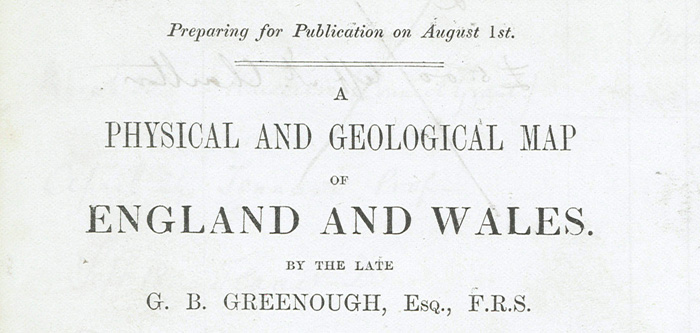
|
| Advertisement for the 3rd edition of the Greenough map, 1865. GSL/COM/MA/3. Click to read the complete page |
Greenough had died in 1855 but had made over the copyright of the map to the Society just after the second edition had been issued. In 1857 the Society was approached by Stanfords, the map seller, with a proposal to purchase the copyright of Greenough’s Map for £150 with a view to producing further editions. Although initially accepted, this was rescinded after a new Map Committee recommended that the Society should produce a revised edition of the Map in house again.
The new committee comprised Sir Roderick Murchison, Colonel Henry James (1803-1877), John Phillips (1800-1874), Robert Godwin-Austen (1808-1884), Joseph Prestwich (1812-1896) and John Morris (1810-1886). Murchison and James were Directors of the Geological and Ordnance Surveys respectively. John Phillips was appointed General Superintendent, overseeing the joint labours of the Committee.
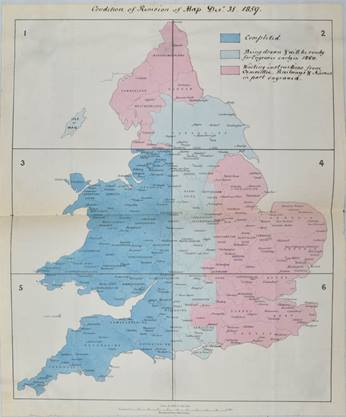
|
|
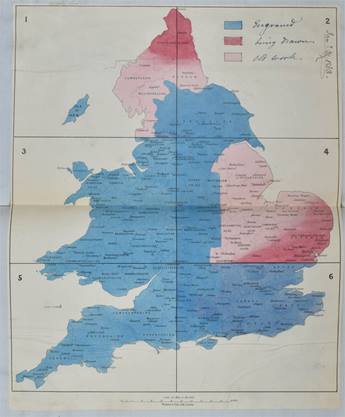
|
Index map showing the work in progress over the six sheets by 31 December 1859. Archive ref: GSL/COM/MA/3. Click to enlarge.
|
|
Index map showing work in progress by 30 January 1863. Archive ref: GSL/COM/MA/3. Click to enlarge
|
The work for each of the six sheets was broken up between the Map Committee members, with each man assigned to delineating the areas they knew best. For instance Phillips worked on the northern counties of England and Prestwich worked on London, Kent, Surrey and East Anglia. Most of the information was taken from their own researches but published maps, notably those produced by the Geological Survey, were utilised heavily. Local experts were also consulted, such as Thomas Sopwith (1803-1879) who was approached for his opinion on the geology around Newcastle.
The map came out in two parts: Sheets 3 & 5 covering Wales and the South West of England were issued first in 1860. The final of the remaining four sheets was not ready until 1865, and the complete map was published in August of that year.

|
Third edition of the Society’s ‘Geological Map of England & Wales’ (1865). Archive ref: LDGSL/979A/3. Click to enlarge.
|
COLOURING
The Committee had pledged their intention that the new map was to stick as closely as possible to Greenough’s carefully chosen palette developed over the first two editions. However this seems to have been abandoned as the end result more closely resembles Roderick Murchison’s newly devised colour scheme which was introduced onto the Geological Survey maps in 1855. Confusingly Murchison's new colours, which are reminiscent of William Smith's, replaced those of his predecessor Henry de la Beche (1796-1855) which were based on the second edition of Greenough's map.
REVISED TITLE

|
Pencil draft of the revised title for the third edition of the map, [Dec 1864]. Archive ref: LDGSL/979A/3. Ironically, considering the aim of the revision was to at last acknowledge the work of William Smith, the new text caused some discontent among the contributors as only members of the Map Committee were referenced by name. Click to enlarge.
|
The geology and colouring of the map were not the only things which had been revised. The title plate now read: "Physical and Geological Map of England & Wales by G B Greenough, FRS (on the basis of the original map of Wm Smith 1815) revised and improved under the superintendence of a Committee of the Geological Society of London from the maps of the Geological Survey of Great Britain, 1836-63, and maps and documents contributed by Sir R I Murchison, Professor Phillips, Joseph Prestwich, R Godwin Austen, and others."
Along with Greenough, the majority of those involved in the creation of the first two editions of the Map were now dead so could not protest. Coincidentally or not John Phillips, who superintended the new Map, was William Smith’s nephew.
SALES
The expenses for the third edition came to £239 10s 6d much of which was paid for by Greenough, this time posthumously from a bequest of £500 which was left to the Society. This also meant that the map did not have to make a profit to pay anyone back, so it was to be sold at nearly cost price: - £2 2s to Fellows and £2 16s to the public.
No figures exist for the number of maps produced, but the expenditure between 1864-1882 for the construction, printing, colouring and distribution of the map was £747 15s 9d in comparison with £635 12s 7d in receipts.
THE END OF THE MAP
Months before the third edition’s official publication, the President William John Hamilton (1805-1867) unhelpfully criticised the accuracy of the map in his Anniversary Address to the Society in February 1865, pointing out errors on the East Anglia and north of England sheets. Following further complaints about its accuracy, a meeting of the Map Committee was held in January 1870 but it was considered wise to hold off on any further revision lest it anger those who had just purchased the map or put off potential customers.
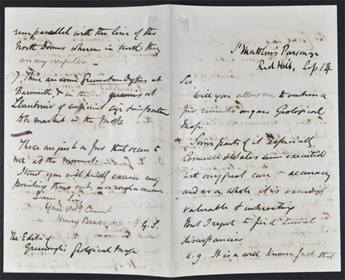
|
|
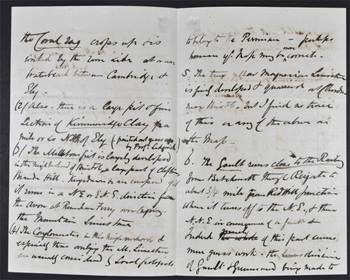
|
| Letter from the Rev Henry Brass, 14 Sep [1865-1869] detailing the errors in the new map. Archive ref: GSL/COM/MAP/3. Click to enlarge. |
The final meetings of the Committee were held in the spring of 1883. Archibald Geikie (1835-1924), Director of the Geological Survey, announced his organisation’s intention of bringing out its own geological map of England on a scale of four miles to the inch in about three years’ time.
The Committee postponed any ideas of revising the map until then. It did not reconvene.
<<Back to main page







